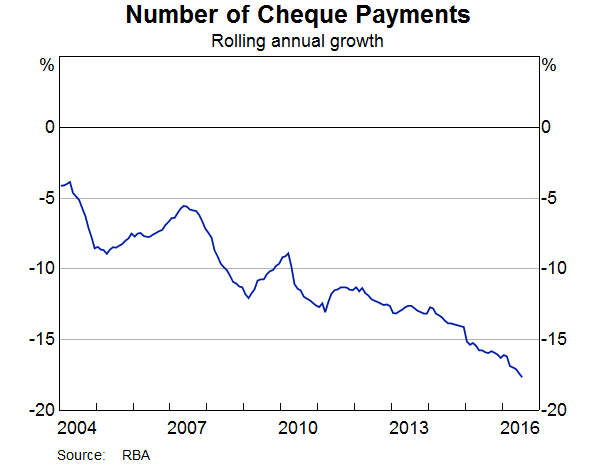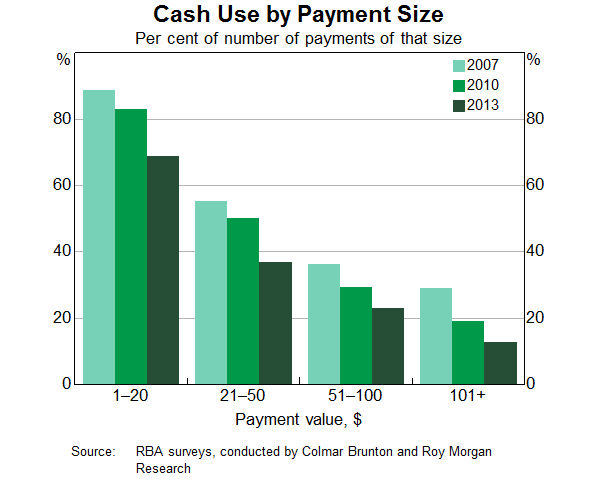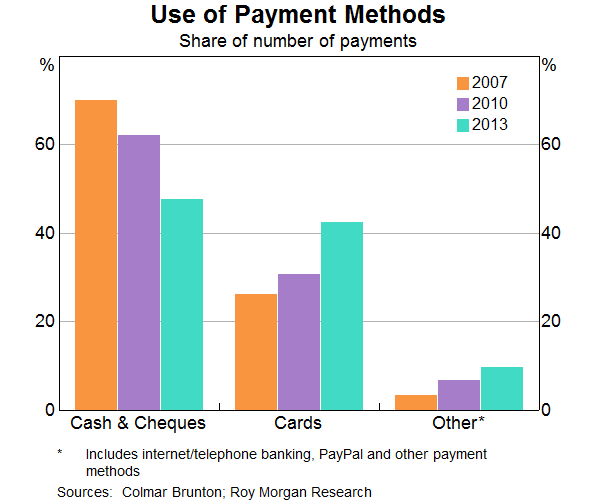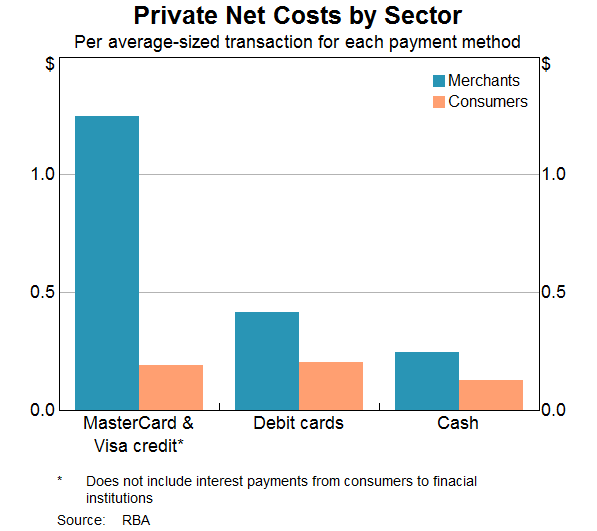Speech Card Payments and the Retail Sector

Malcolm Edey[*]
Assistant Governor (Financial System)
Australian Financial Review Retail Summit
Melbourne –
Introductory Remarks
This is a conference about the retail industry, not the payments industry. However, a retail business is not a business if the retailer cannot get paid. And a retailer won't be at their most competitive if their payment costs are higher than they should be. This is an issue staff at the Reserve Bank think about every day, and one that I hope retailers are taking a close interest in as well.
Today I'll talk about how the way we pay is changing, and what it means for retail businesses. I'll also talk about the Reserve Bank's role as a payments regulator and about some of the things that are just around the corner in payments.
The Changing Nature of Payments
A good place to start is an observation that will not be lost on anyone here. That is that the nature of the payments we use is changing, and changing quite rapidly at the moment. Probably the clearest example to most people has been the take-up of contactless, or tap-and-go, card payments. These have taken off extraordinarily quickly in Australia, to the point where Australia is thought of as the leading contactless market in the world. This is a technology that offers a benefit to both consumers and merchants in terms of the time taken to process a payment, and as a result it has been embraced – but many merchants might also notice that their payments costs have risen because of the resulting change in their payments mix. This is a good example of the complex dynamics of competition in the retail payments system.
But the rise of contactless payments is only one of a range of changes that have been occurring to the payments system over time – some of which you might have noticed, some of which you have probably never thought about.
Possibly the most important trend we are seeing is the steady decline in the use of traditionally paper-based payments. Think of when was the last time you wrote or received a cheque. In 2000 the average Australian wrote around 35 cheques per year. In 2015/16 that was down to six. What is more, while cheque use has been declining for two decades, the decline if anything is accelerating; after falling by an average of about 13 per cent per year in the preceding five years, the number of cheques written fell by 17 per cent in 2015/16 (Graph 1).

We have been observing the decline in cheques for many years, but more recently it has been a decline in the use of that other traditionally paper instrument – cash – that has been attracting attention[1]. The only real way to adequately measure the use of cash is to survey the users – something the Reserve Bank does via a consumer diary once every three years. We ran the first of these surveys in 2007, when a large majority of consumer payments – 69 per cent – were made with cash. By 2010, that percentage had fallen to 62 per cent and by 2013, 47 per cent, with the decline occurring across all payment values (Graph 2). We will run the survey again this year, but it seems a safe bet that there will be a further, probably quite large, decline in cash use[2].

This trend is not all about people falling out of love with cash; a significant factor is the rapid rise in online commerce, where of course cash is not an option.
So what has filled the gap left by our paper instruments? In the retail space it is largely cards, which have grown by an average of 11 per cent per year over the past five years (Graph 3). This reflects cards' large share in online commerce, as well as their having gained ground at the retail point of sale. Based on the Bank's consumer survey, card payments made up 43 per cent of all consumer payments in 2013, and 55 per cent of those over 50 dollars. The ubiquity of card payments is one reason we care a lot about how those systems operate, as I will discuss more a bit later.

It is also worth noting that in the period measured by our survey, BPAY also gained an increasing share of the market, while the relative newcomer, PayPal showed strong growth from a low base. I will speak a little later about some of the other types of payments that might start to register on the radar in the coming years.
The Cost of Payments
Of equal interest to these broader trends in payments usage is the cost of payments. The retail sector clearly has a strong interest in the cost of payments to merchants, and while the Reserve Bank is also interested in this, its principal focus when evaluating the efficiency of the payments system is the resource cost of payments – that is, how much it costs the economy in total to produce a payment – abstracting from the various fees that determine the cost to any single party or sector. Determining resource costs is a large job, requiring detailed information on financial institutions' costs and things like the cost of processing time for merchants.
The Reserve Bank last went through this exercise in 2014. The most comforting news from that study was that the resource cost of consumer to business payments had declined as a percentage of GDP since the previous cost study in 2006, from 0.80 per cent to 0.54 per cent, even though the number of transactions had risen. Despite the favourable trend overall, the mix of payments within the total acted in the direction of increasing costs.
Looking across the main non-cash retail systems, we see that, unsurprisingly, the highest per-transaction resource costs were generated by the cheque system, with each cheque written costing the economy about $5.12, if account overheads are ignored (Graph 4). This is not surprising given the cost of shipping and processing physical cheques, although there have been some efficiency improvements in the cheque system since the time of the study.

Perhaps of more current interest to the retail sector is the cost of our card systems. Credit cards are quite costly at around 94 cents for the average sized transaction, while MasterCard and Visa debit are less costly and eftpos uses the fewest resources of any of the card systems, at around 45 cents per transaction.
The broad relativities between the resource costs of these systems is similar to those faced by merchants. Another way to think about that is that it is merchants who, by and large, bear the cost of payments. This is largely achieved by the way fees are used in these systems. I think the most telling illustration of that is to compare the actual costs faced by merchants to the costs faced by consumers once fees and benefits to consumers, like interest-free periods and reward points, are taken into account. What you will see is that, despite being more expensive to produce and more costly to merchants, on average a credit card transaction costs a consumer slightly less than a debit card transaction (Graph 5). These are the incentives that shape payment choices by consumers.

Payments as a Business
The arrangement of incentives I have just shown you is a defining feature of card payment systems, and one that the Reserve Bank has devoted a great deal of attention to over many years.
The principal reason that the relative cost of cards to consumers looks so different to the resource cost of cards is the payment of interchange fees in these systems. An interchange fee is a fee paid from a merchant's bank to the cardholder's bank every time a card payment is made. While cardholders and merchants have little visibility of these fees, their effect is nonetheless substantial. They place a floor under the fee that a merchant is charged by its bank to accept cards and they help fund the rewards, interest free periods and other benefits that encourage consumers to use a particular card. In large part, this can occur because many merchants feel that they cannot refuse to accept some types of card payments. This in turn means that competition, both between financial institutions and between card schemes, can be directed towards influencing the card that the consumer takes from their wallet to make a payment.
The effect of interchange fees has been well understood in Australia for many years, with the Reserve Bank first requiring interchange fees to be reduced in 2003 following earlier joint work with the Australian Competition and Consumer Commission. A number of other regulators internationally have subsequently followed the Reserve Bank's lead.
The role of interchange fees in affecting payment choices is so powerful that, even under the interchange fee caps applied in Australia, card schemes have seen benefit in setting very high interchange rates on some categories of cards – to encourage growth in that segment – offset by much lower rates on transactions at some ‘preferred’ merchants. The unfortunate effect of this is that those ‘preferred’ merchants pay very low fees on all transactions, while other merchants pay the much higher rates that support generous rewards programs on super-premium cards. Such a card might cost a large merchant around 0.2 per cent of transaction value, whereas a small merchant that did not have a ‘preferred’ rate, might be paying up to 2 per cent. The Reserve Bank estimates that in 2015, non-preferred merchants on average faced interchange fees more than half a per cent higher than preferred merchants.
This is one of several factors that led the Reserve Bank to conclude in 2015 that a review of card regulation was warranted.
The RBA as a Payments Regulator
Before I get onto the details of that review, I would like to revisit how the Reserve Bank has come to be involved in this area of regulation.
Legislative reforms in 1998 following the Wallis Committee's Final Report enshrined the long-understood central bank responsibility for the stability of the payments system in the Reserve Bank Act. They also gave the Bank for the first time an explicit mandate to promote competition and efficiency in the payments system and some new powers that would allow it to pursue that mandate. The Wallis Inquiry had also provided some guidance on areas where this new mandate could be applied, including card interchange fees.
These developments set the scene for a period of fact finding, analysis and eventually regulation to cap interchange fees and force the removal of ‘no-surcharge’ rules. Interchange fees on MasterCard and Visa cards were reduced in 2003 from around one per cent of transaction value to 0.5 per cent. Fees on MasterCard and Visa debit cards were reduced in 2006 to 12 cents per transaction.
While at the time there were predictions from some quarters that regulating interchange fees would be catastrophic for card systems, as we have seen, they have thrived. Regulators in a number of other countries have now followed Australia's lead in this area of regulation and indeed some – notably the European Union – have gone further.
Nonetheless, while we think our cards regulation has been very successful, we have known for some time that there were elements of it that could be improved upon – either because the payments system has evolved since the regulation came into force, or because those affected by regulation have adjusted their behaviour over time. This led us to initiate a review of cards regulation in 2015, which was completed in May this year. Some changes to regulation have already occurred as a result, with the remainder coming into force over the coming year.
There were three key elements of the reform package that the Bank announced in May.
First, the Bank considered whether the current regulated levels of interchange fees remained appropriate, particularly given that, as I mentioned, there were now examples of lower interchange fee caps in other parts of the world. The Bank decided to leave credit card interchange fees unchanged, but to further reduce the level of debit card interchange fees – from 12 cents to 8 cents. This decision reflected the fact that the average size of MasterCard and Visa debit card transactions had fallen by 43 per cent since 2008, meaning that interchange fees had been rising as a percentage of transaction value.
I mentioned earlier that specifying the interchange cap as an average had resulted in some – typically small and medium-sized merchants – bearing much more of the burden of high-cost cards than ‘preferred’ merchants. The Bank has now decided to limit this effect by placing an absolute limit on the level of interchange fees for any card or any transaction in addition to the cap on the average. A limit of 0.8 per cent will apply to credit cards and 15 cents (or 0.2 per cent) to debit cards. The current 2 per cent interchange fees applying to some super-premium cards will no longer be possible from July 2017. This will benefit non-preferred merchants. Some further technical changes to how the caps are applied will reduce average interchange fees by reducing upward drift in the average over time.
The second element of the May reform package is to place what we refer to as American Express companion cards on the same regulatory footing as MasterCard and Visa cards. Traditional American Express cards have been issued by the company itself, with Amex also arranging acceptance of those cards for the merchant. However in the mid 2000s, banks began issuing some American Express cards under license. Under these arrangements, American Express paid fees and incentives to card issuers, which had a similar effect to interchange fees – funding rewards points and influencing payment choices by consumers. But because these payments were unregulated, the rewards tended to be significantly higher than those offered on MasterCard and Visa Cards. This raised questions about whether the regulatory regime was fully competitively neutral.
From July 2017 the Bank will now cap interchange fees and other payments to issuers in an equivalent fashion across American Express companion, MasterCard and Visa cards. Traditional American Express cards, which have no equivalent to interchange fees, will not be subject to fee regulation.
Finally, the May package further strengthens the regulation of card surcharging.
Giving merchants the ability to signal to consumers through a surcharge that some payment methods are more costly to accept than others has been an important element of payments regulation in Australia. The overwhelming majority of merchants that have taken up the option of surcharging have done so at a level that recovers or under-recovers their card acceptance costs. However there has been community concern about a small number of cases where card surcharges exceed card acceptance costs – at least for some transactions. The lightning rod for these concerns has been airlines and their fixed dollar surcharges, which clearly over-recover card acceptance costs for low value airfares. In addition, while the Bank had in place a regulatory framework that could cap card surcharges to merchants' card acceptance costs, there were concerns about how these caps could be enforced, given the limits of the Reserve Bank's powers.
The May package of reforms provides a simpler measure of the allowable surcharge, which is already in force for large merchants and will take effect for other merchants from September next year. In order to make it as simple as possible to understand payment costs, banks and other organisations that provide card acceptance services will be required to give each merchant a clear statement of their acceptance cost for each card scheme. A merchant will be able to use this to set its surcharge, or could include some limited other costs if they can be supported with receipts or statements. One implication of the revised framework is that merchants will generally no longer be able to apply fixed dollar surcharges.
The other key change from the previous framework is that the government has passed legislation to ban excessive surcharging. This step will give the Australian Competition and Consumer Commission the power to enforce the ban.
The ban on excessive surcharging for large merchants has now been in place for a few weeks. The airlines have responded. Qantas, for instance, has moved from a $7 fixed fee on domestic flights on credit card payments to 1.3 per cent, with a cap of $11 for higher cost fares. For debit card payments they now surcharge 0.6 per cent. That means a $200 fare would be surcharged $2.60 for a credit card payment, compared with $7 previously. We also know that the large event ticketing agents have removed their card surcharges, which seems appropriate for an industry where alternatives to paying by card in most cases are limited.
This should already have eased the broader community's concerns about excessive surcharges to an extent. By this time next year we will have a framework in place for all merchants which should give consumers confidence that any surcharges they pay are reasonable, while at the same time providing merchants with a much clearer understanding of their payment costs.
The Future
I began by talking about the decline of some of last century's payment systems. I would now like to turn briefly to the future, because there are some important developments just around the corner.
One trend that seems very likely in the near term is the migration of contactless card transactions to mobile phones. Not everyone will see appeal in this, but the latest generation of mobile wallets are secure and convenient and can rely on what is now a very widespread contactless acceptance network in Australia. There is little doubt that the prospect of being able to leave home with only a mobile phone will have appeal in some circles. Mobile wallets bring new players and new processes into the payment flows, and the Bank expects to remain closely engaged with these developments in the period ahead.
It would be unfortunate if there were a perception that the Bank's only contribution to the efficiency of the payments system was regulation of card systems. We do in fact have higher ambitions. In my view the most significant contribution to the future of the payments system that the Bank has made in recent times – certainly in my time as Assistant Governor in this area – has not been regulation, but playing the role of catalyst for a major industry project to create a new payments system – the New Payments Platform, or NPP.
The creation of the NPP has flowed from the Strategic Review of Innovation in the Payments System that was undertaken by the Bank between 2010 and 2012. In finalising the review, the Bank identified a number of important features that electronic payment systems were not able to provide in Australia and challenged the payments industry to look for a solution. To the industry's great credit it took up that challenge and has focused a very large industry effort on filling those gaps through the delivery of the NPP in the second half of next year.
The NPP will allow individuals and businesses to make account-to-account funds transfers, with the recipient having access to those funds in most cases in a matter of seconds. That will be possible at any hour of the day or night, seven days a week, regardless of the financial institutions that the sender and receiver bank with. The sender will not need to know the BSB and account number of the recipient; they will be able to use a phone number, email address or ABN to address the payment. And importantly, it will be possible to send a much larger amount of information with a payment than the 18 characters permitted through our current system. That will potentially represent an enormous benefit to business users of the system in particular. Finally, with an eye to the rapid pace of innovation, the structure of the NPP will allow new types of third party commercial services to be delivered through the system, once the initial service, to be offered by BPAY, is up and running.
Conclusion
This will be my last opportunity to speak in an official capacity on payments system issues. I am proud of the things that the Reserve Bank has been able to achieve in this area, both through world-leading regulation and through playing the catalyst role that I spoke of. Efficiency of the payments system is not always a high-profile topic, but it is a tremendously important one when you consider the 28 million non-cash payments made each and every day in Australia. It is certainly in the interests of the people in this room to take a deep interest in payments, and I would encourage you to continue to do so. I think retailers understand that our reforms have worked to reduce their payment costs, and I thank all those retail organisations that have participated in our policy consultations and supported the direction of reform.
Endnotes
I thank Darren Flood for his extensive assistance in preparing this speech. [*]
The replacement of paper by polymer banknotes does not change the essential point here. [1]
At the same time, it should be noted that the absolute value and number of banknotes in circulation is still increasing, even though their relative use is declining. [2]